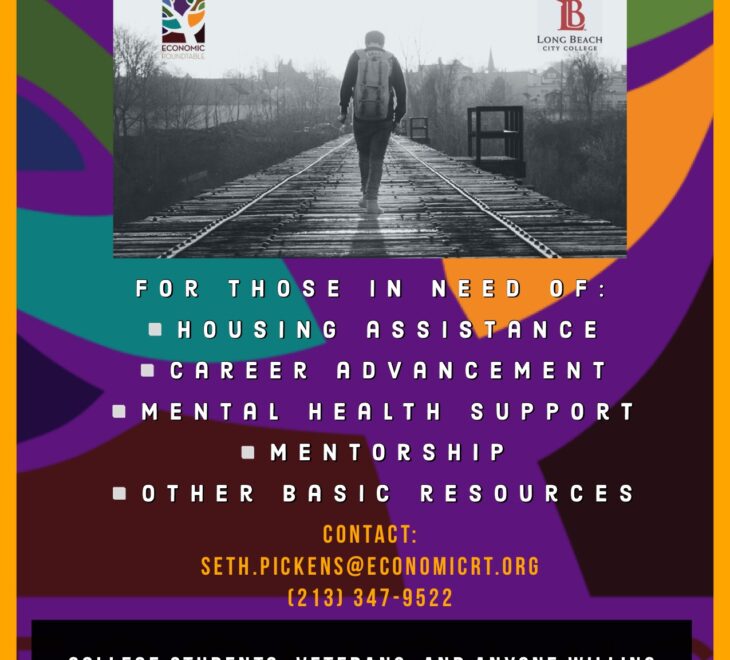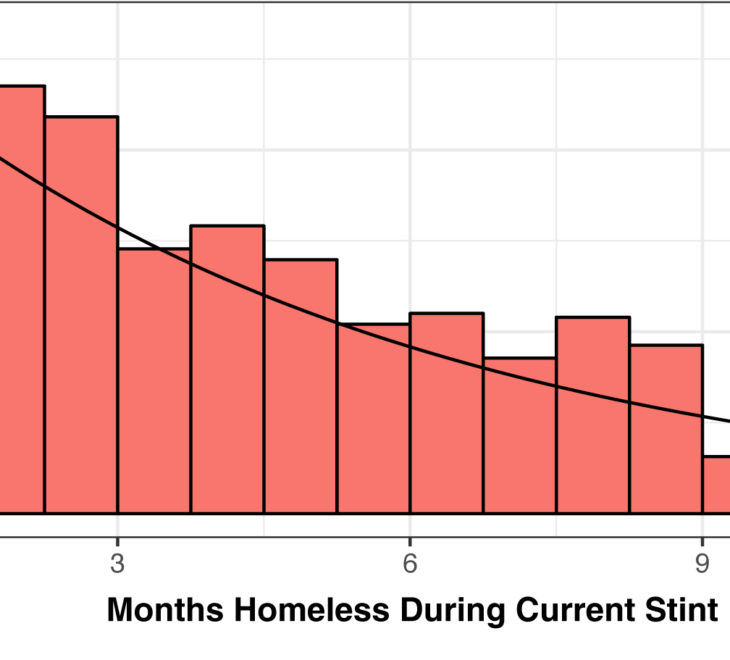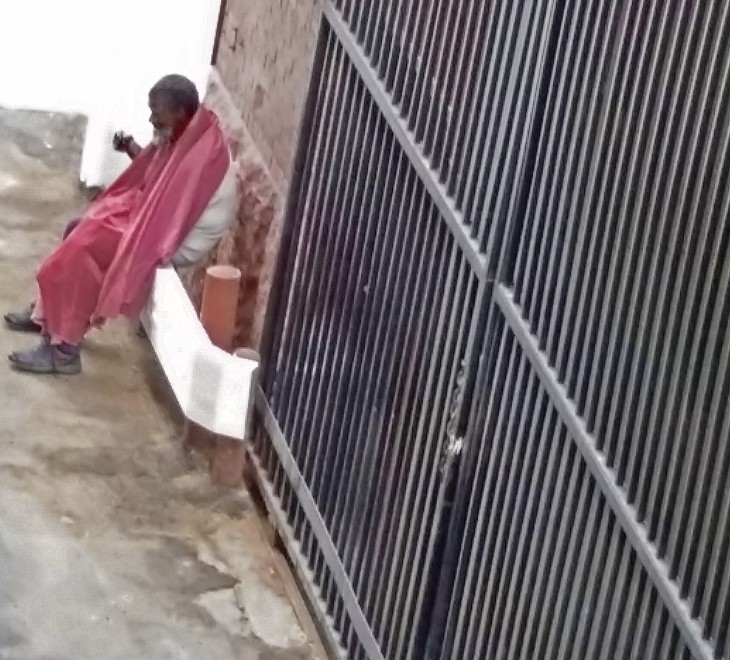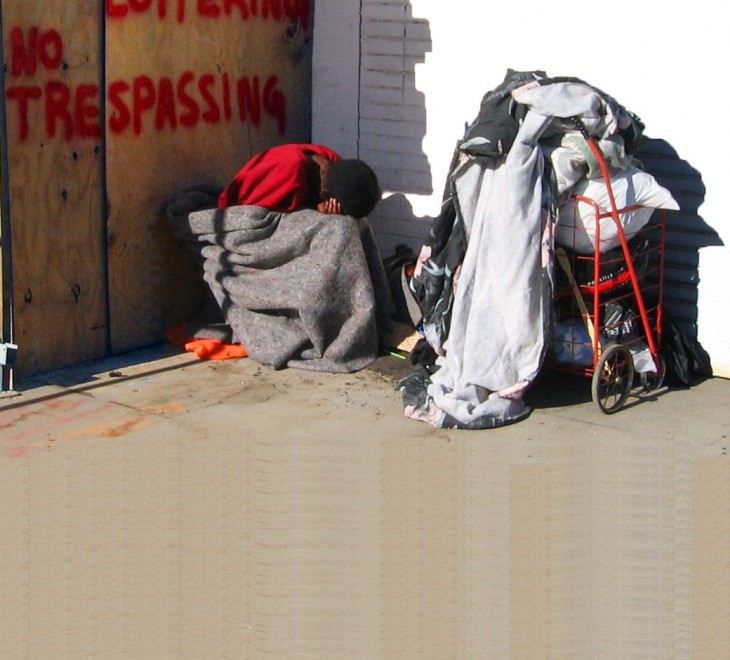Overview
We can’t navigate without a map. If we can’t see the whole picture of homelessness, we can’t begin to solve the problem. This meta-analysis brings together 26 point-in-time data sets to provide a single panoramic description of people without homes who are living in places not meant for human habitation. The objective is to identify the common reality underlying the data and provide a description that is more comprehensive and reliable than information from any single source.
Escape Routes
The attributes of people experiencing homelessness change if they remain homeless. Poverty and inability to pay for housing may be the precipitating cause for first becoming homeless. Over time, however, social disconnection and legal, medical and behavioral health problems emerge as increasingly formidable barriers to escaping homelessness.
Chronic homelessness is the outcome of repeated system-wide failures to provide lasting help. To reduce the size of the chronically homeless population, it is necessary to reduce the number of people who have protracted and repeated episodes of homelessness. This requires system-wide engagement by the entire range of public and private service providers that touch or should touch the lives of individuals experiencing homelessness.
In addition to building affordable housing, the path for ending Los Angeles County’s crisis of chronic homelessness is through identifying individuals with a high risk of becoming chronically homeless early after the onset of homelessness and intervening with coordinated system-wide assistance that supports a permanent exit from homelessness before the problem is catastrophic.
Homelessness results from a cascade of system-wide failures and requires system-wide engagement. The homelessness response system can’t be the only system providing thoughtful, targeted interventions to individuals who fall into homelessness.
The pragmatic argument for early interventions such as employment is that they cost much less than the roughly $300,000 in subsidies required to make a housing unit permanently affordable for a formerly homeless person. If early interventions are accurately targeted on individuals who have a high risk of becoming chronically homeless, the avoided public costs will more than offset the cost of the intervention.
This is not to say that employment interventions are inexpensive. The package of system-wide services that are needed includes, but isn’t limited to, temporary housing, temporary income maintenance, training, employment subsidies, child care, and transportation.
Greatly increasing the supply of permanently affordable housing continues to be crucial. Jobs and other early interventions must be parallel efforts that augment rather than divert resources from housing chronically homeless individuals.
Precarious Housing
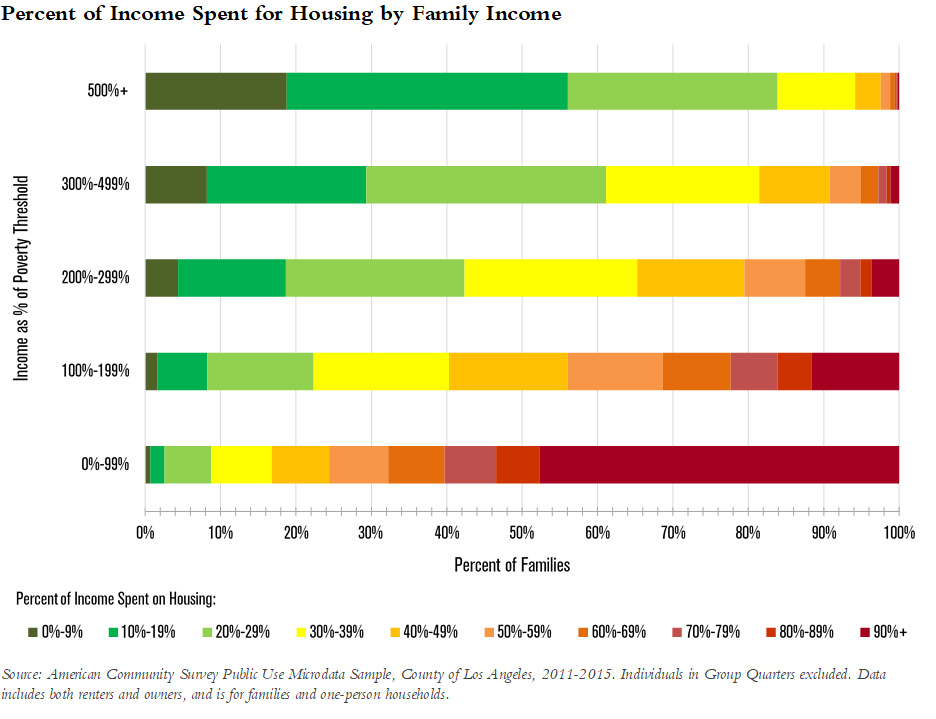 A large population experiences short episodes of homelessness. Out of this larger population, some individuals’ homeless episodes reoccur and grow longer, resulting in persistent homelessness.
A large population experiences short episodes of homelessness. Out of this larger population, some individuals’ homeless episodes reoccur and grow longer, resulting in persistent homelessness.
Almost 600,000 Los Angeles County residents are in poverty and spend 90 percent or more of their income on housing. However, on any given day, over 90 percent of these extremely precariously housed individuals succeed in avoiding homelessness through employment, public assistance, housing support, help from friends and relatives, social services, and the generosity of people in their lives.
Each one percentage point increase in the success rate of precariously housed individuals avoiding homelessness will reduce the number of people who become homeless by at least 10 percent. This can be achieved by strengthening the tools precariously housed people already use to remain housed.
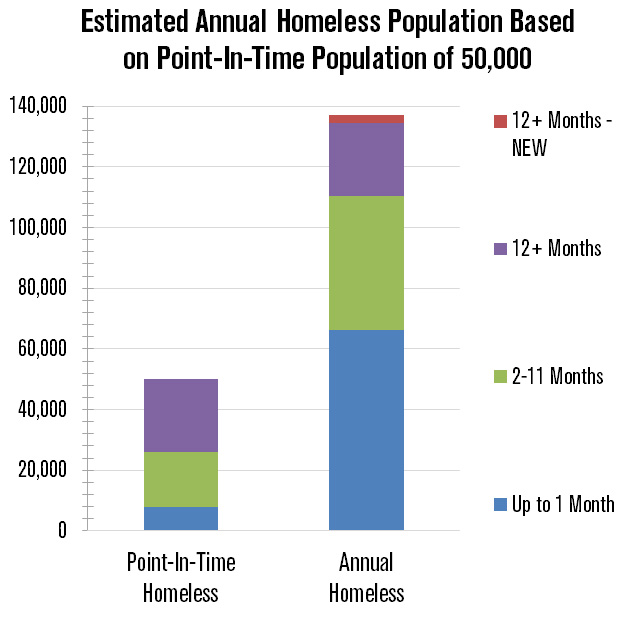 The large share of the homeless population that experiences homelessness for only a short period of time has important operational implications. There is more diversity among people experiencing homelessness and often greater capacity to achieve an exit than is commonly appreciated.
The large share of the homeless population that experiences homelessness for only a short period of time has important operational implications. There is more diversity among people experiencing homelessness and often greater capacity to achieve an exit than is commonly appreciated.
Looking at an annual population scenario, 48 percent of individuals are estimated to be homeless for one month or less, and there is a progressive decline in the number of people who remain homeless from one month to the next until the twelfth month, when the long-term homeless population balloons.
Further reducing the share of people who continue to be homeless from one month to the next is essential if we are to reduce the number of people who become stuck in chronic homelessness. Even a ten percent increase in the monthly exit rates from homelessness could reduce the number of people who become persistently homeless by almost half.
Based on a scenario of the annual homeless population, our preliminary estimate is that 2,600 to 5,200 individuals fall into persistent homelessness each year. Many of these individuals also have disabilities, marking them as chronically homeless. Los Angeles County’s current population of chronically homeless individuals is the cumulative outcome of many years of slow attrition into persistent homelessness.
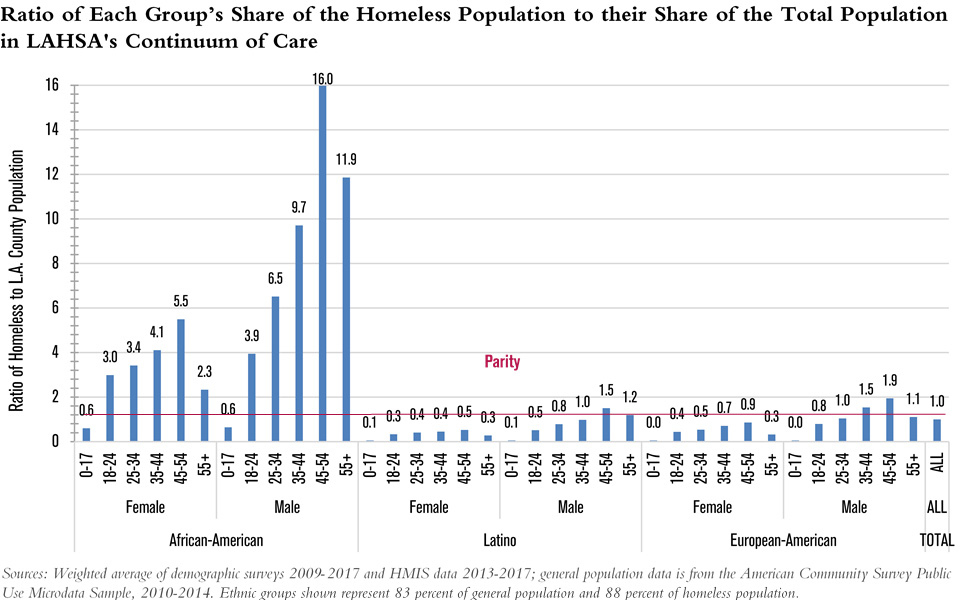 Reducing chronic homelessness by increasing early and lasting exits from homelessness requires targeting the right interventions on the right individuals as quickly as possible.
Reducing chronic homelessness by increasing early and lasting exits from homelessness requires targeting the right interventions on the right individuals as quickly as possible.
Attributes of Homeless Residents
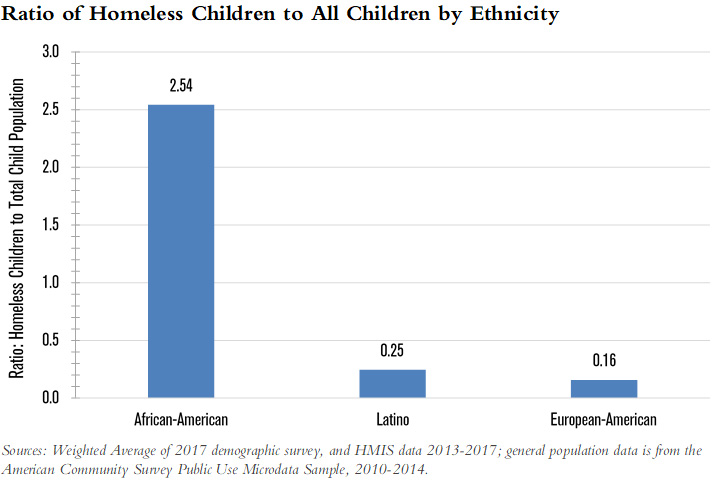 African-American boys and girls 0 to 17 years of age are extremely over-represented among children experiencing homelessness. The rate of homelessness for African-American children is 10 times greater than the rate for Latino children and 13 times greater than the rate for European-American children. The ethnically disproportionate burden of homelessness among African-American adults begins in childhood.
African-American boys and girls 0 to 17 years of age are extremely over-represented among children experiencing homelessness. The rate of homelessness for African-American children is 10 times greater than the rate for Latino children and 13 times greater than the rate for European-American children. The ethnically disproportionate burden of homelessness among African-American adults begins in childhood.
African-American men 45 to 54 years of age are 16 times more prevalent among homeless residents than in the overall population.
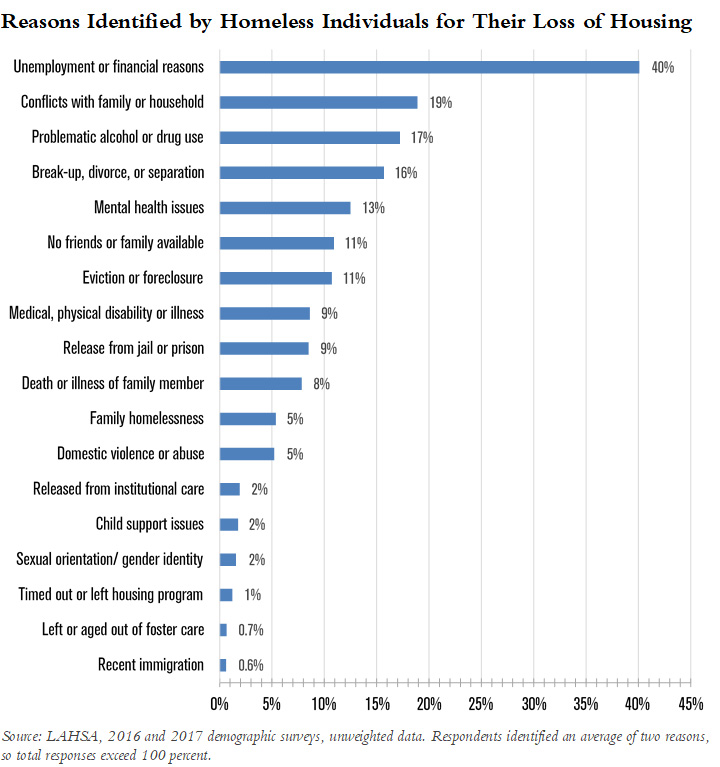 By far the most frequently given reason for homelessness is unemployment, lack of cash aid, and consequent lack of money–cited by 40 percent of individuals. A frequent compounding factor is breakdown of social connections. This includes family conflict, breakup, violence, and death.
By far the most frequently given reason for homelessness is unemployment, lack of cash aid, and consequent lack of money–cited by 40 percent of individuals. A frequent compounding factor is breakdown of social connections. This includes family conflict, breakup, violence, and death.
Younger individuals and women are the most likely to identify social disconnection as a reason for being homeless. Over a third of homeless adults and over half of women report having experienced violence at the hands of someone close to them.
Across all age groups of unsheltered homeless adults 25 years of age and older, over a quarter said that their first homeless episode occurred when they were between 18 and 24 years of age, a quarter say it was when they were 25 to 34, and a fifth say it was when they were children.
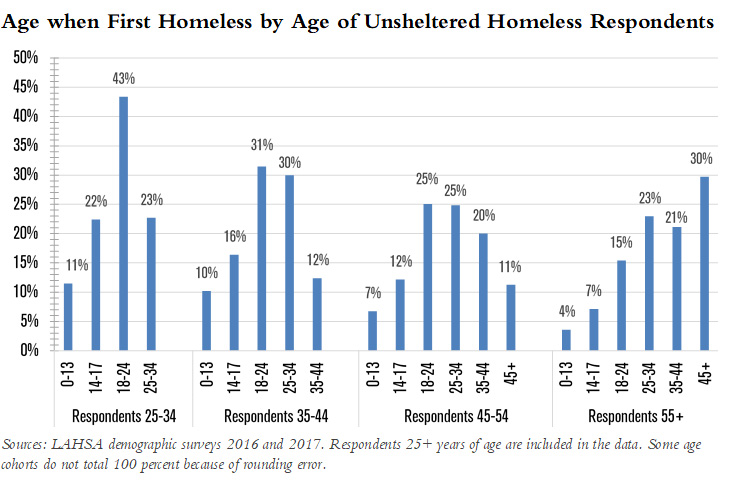 However, the age profile for the onset of homelessness varies by the age of the respondent, with the onset shifting to older ages for respondents who are older. This suggests that for many individuals, even older individuals, the entry into homelessness has been recent.
However, the age profile for the onset of homelessness varies by the age of the respondent, with the onset shifting to older ages for respondents who are older. This suggests that for many individuals, even older individuals, the entry into homelessness has been recent.
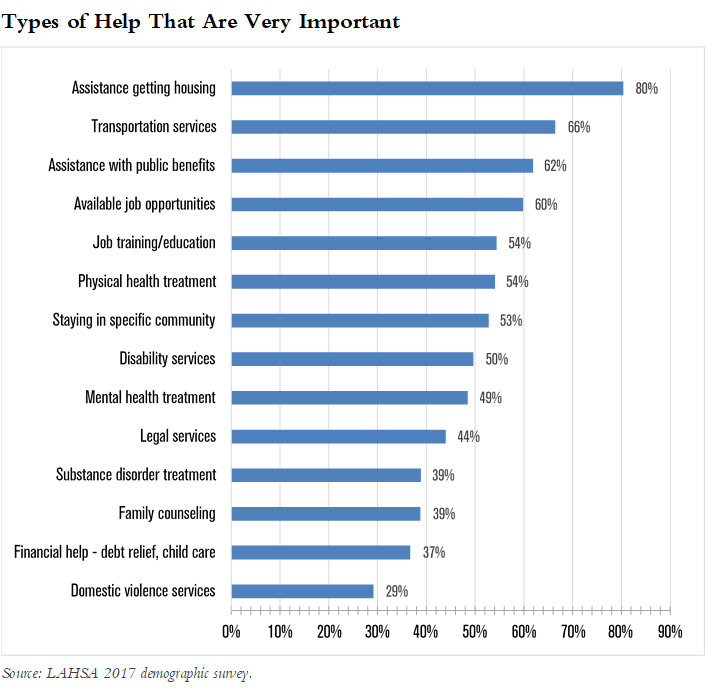 When asked what kind of help they need to escape homelessness, individuals living on the street say that getting housing is the most important type of help, followed by transportation, public benefits, jobs, job training or education, and health care.
When asked what kind of help they need to escape homelessness, individuals living on the street say that getting housing is the most important type of help, followed by transportation, public benefits, jobs, job training or education, and health care.
These priorities are largely consistent across ethnic and gender groups. The greatest divergence in priorities is about the importance of a job or job training and is based on age and length of time homeless. Developing skills and finding a job is very important for almost three-quarters of individuals 25 to 34 years of age and people who are homeless for the first time, but this priority diminishes with age and length of time homeless.
The condition of homelessness compounds the decreased vitality that often accompanies age, resulting in serious health problems among nearly three-quarters of older homeless persons. Serious health disorders are reported two and a half times more frequently by chronically homeless individuals than by first-time homeless. Serious mental illness is reported by over half of chronically homeless individuals versus a fifth of first-time homeless.
Visible Homelessness
The most basic distinction in homeless dwelling places is between staying in a homeless shelter and residing on the street where one is visibly homeless. Reasons why homeless individuals may choose not reside in emergency shelters include the lack of lasting solutions at the end of the shelter stay, particularly a source of income or housing after people reached the time limit for their program.
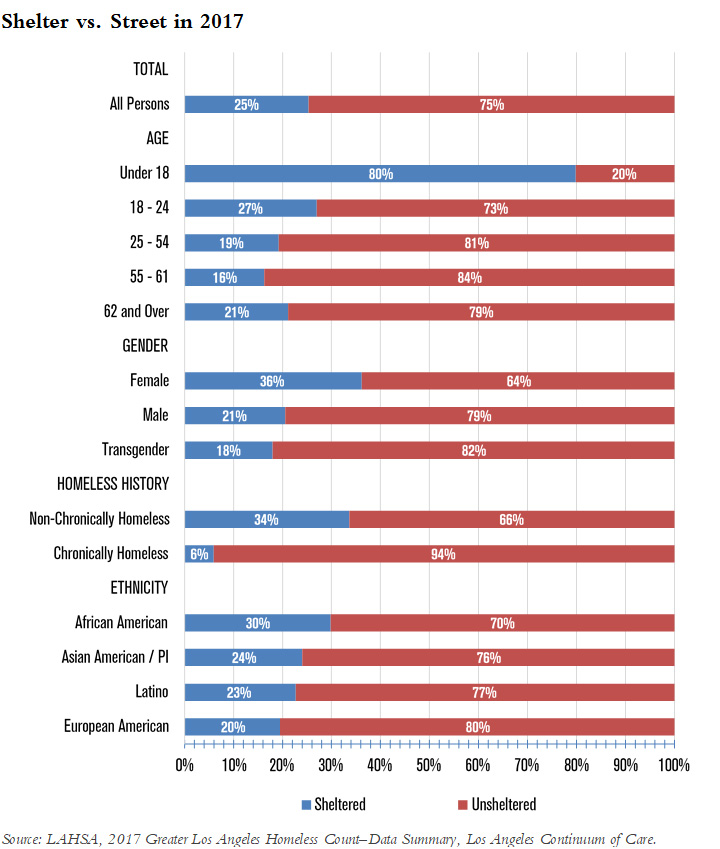 Children are the most likely to find refuge in a homeless shelter, followed by women, and then by non-chronically homeless individuals. Among the one-fifth of children who are unsheltered, half reside in vehicles. This means that on a given night, the dwellings for 10 percent of homeless children are something less secure than an emergency shelter or a vehicle.
Children are the most likely to find refuge in a homeless shelter, followed by women, and then by non-chronically homeless individuals. Among the one-fifth of children who are unsheltered, half reside in vehicles. This means that on a given night, the dwellings for 10 percent of homeless children are something less secure than an emergency shelter or a vehicle.
The long-term trend in the dwellings occupied by unsheltered individuals is that persons sleeping on sidewalks make up a decreasing share of homeless sightings; and tents and makeshift shelters make up an increasing share. There is a progression that accompanies age in the increasing share of unsheltered individuals who occupy tents and makeshift shelters.
Sleeping on sidewalks and alleys is most prevalent among youth 18-24 years of age, accounting for almost half of the locations where unsheltered youth spend the night.
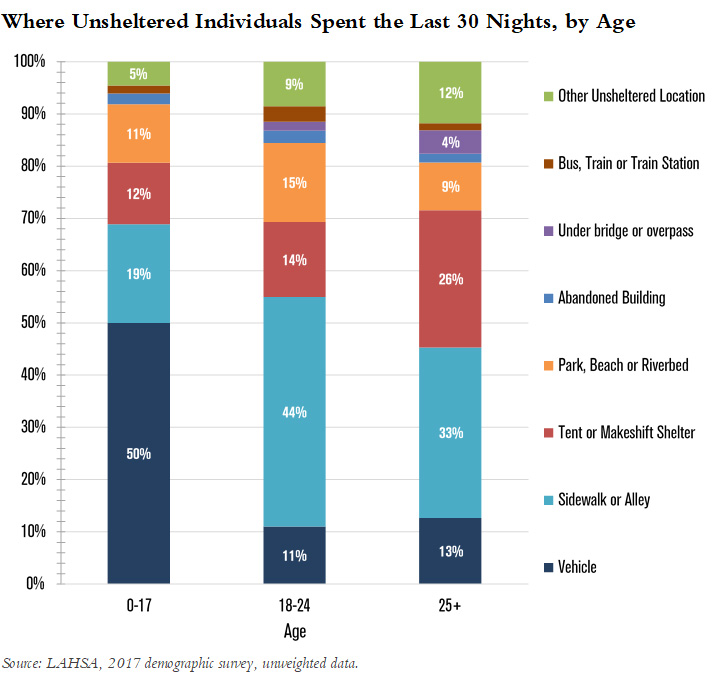 Roughly a third of unsheltered homeless individuals live in a vehicle. However, the rate of vehicle occupancy drops by over half among individuals who have been homeless 12 months or longer. This may well be because the substantial cost of vehicle ownership is compounded by lack of legal parking places, parking tickets and vehicle impoundment.
Roughly a third of unsheltered homeless individuals live in a vehicle. However, the rate of vehicle occupancy drops by over half among individuals who have been homeless 12 months or longer. This may well be because the substantial cost of vehicle ownership is compounded by lack of legal parking places, parking tickets and vehicle impoundment.
In most cases, vehicles are the best dwelling option for unsheltered individuals. It is beneficial and cost-effective to help homeless individuals retain their vehicles. This strategy includes providing legal places to park together with sanitary facilities for occupants of the vehicles. It can also include assistance in paying vehicle registration and maintenance costs.
Justice System Involvement
One of the most consistent characteristics of homeless adults is a history of incarceration. Fifty-eight percent of unsheltered men 25 years of age or older and 42 percent of women report having been incarcerated. A third of reported stints of incarceration are in state prison and the other two-thirds in county jail.
Although three-quarters did not have juvenile records and the onset of involvement in the criminal justice system occurred as adults, adult incarceration foreshadows homelessness for half of men and a third of women.
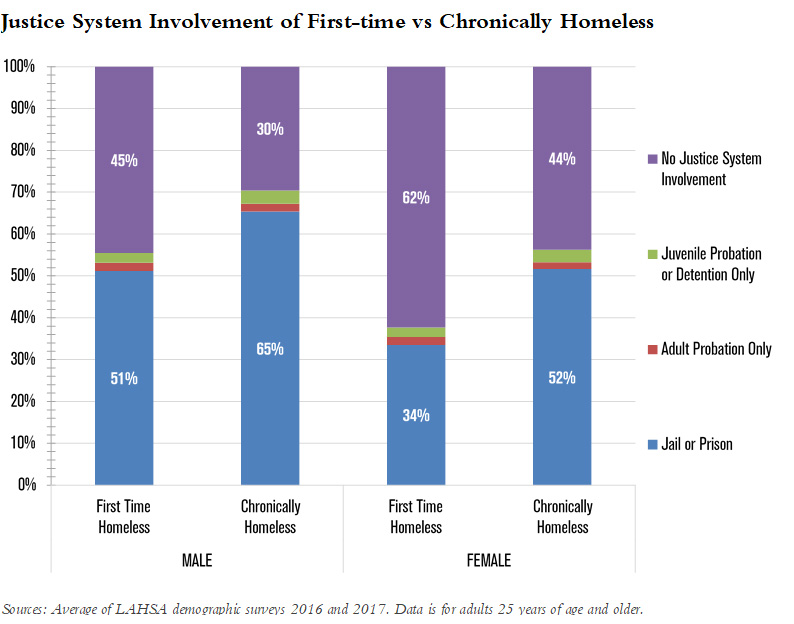 Prolonged exposure to homelessness is associated with an increased rate of incarceration. The frequency of incarceration histories is a quarter again higher among chronically homeless men and half again higher among chronically homeless women than among those who are newly homeless.
Prolonged exposure to homelessness is associated with an increased rate of incarceration. The frequency of incarceration histories is a quarter again higher among chronically homeless men and half again higher among chronically homeless women than among those who are newly homeless.
Overall, homeless residents are involved in a very small share of crimes in the City of Los Angeles. They are suspects in roughly one out of 50 crimes and the victim in about one out of 100 crimes. The predominant type of police encounter for homeless residents has been loitering or sleeping in a public place, accounting for two-thirds of homeless arrests from 2010 through 2017.
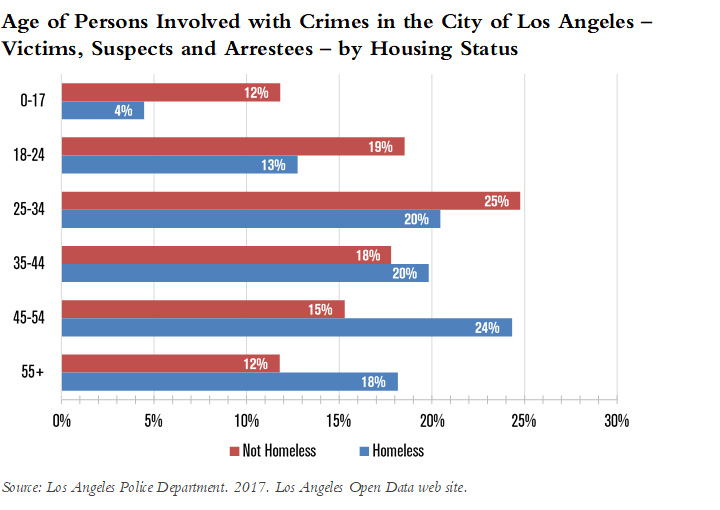 Homeless residents’ encounters with the police increase with age, peaking among individuals who are 45 to 54 years old. In contrast, non-homeless encounters with the police peak among individuals who are 25 to 34 years old and decrease thereafter. The higher frequency of justice system involvement among older homeless individuals appears to be associated with the duration of homelessness, since older people tend to have longer histories of homelessness.
Homeless residents’ encounters with the police increase with age, peaking among individuals who are 45 to 54 years old. In contrast, non-homeless encounters with the police peak among individuals who are 25 to 34 years old and decrease thereafter. The higher frequency of justice system involvement among older homeless individuals appears to be associated with the duration of homelessness, since older people tend to have longer histories of homelessness.
This points to the importance of continuing and expanding interventions for homeless individuals while they are incarcerated and more readily accessible for services and discharge planning.
Families and Children
Homeless families are fragile. Half of all homeless women and a third of men report that they have children. Nearly a tenth of all homeless individuals 18 years of age and older are accompanied by a child, this includes nearly a fifth of women and a quarter as many men. Others have children in institutional care, and still others have children who have reached adulthood.
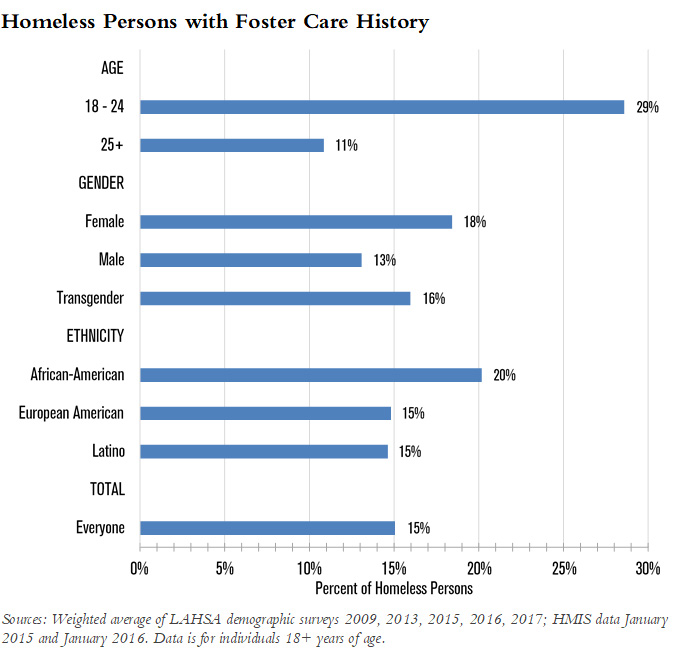 For every one homeless parent accompanied by a child, 1.5 parents have a child in institutional care. This includes one parent who has a child in foster care and slightly less than one parent who has a child in juvenile detention. Because some parents have children in both forms of institutional care, the ratio is one to 1.5.
For every one homeless parent accompanied by a child, 1.5 parents have a child in institutional care. This includes one parent who has a child in foster care and slightly less than one parent who has a child in juvenile detention. Because some parents have children in both forms of institutional care, the ratio is one to 1.5.
Homelessness and institutional care are linked across generations. One-seventh of all homeless adults and nearly one-third of homeless youth 18 to 24 years of age, report that they were in foster care.
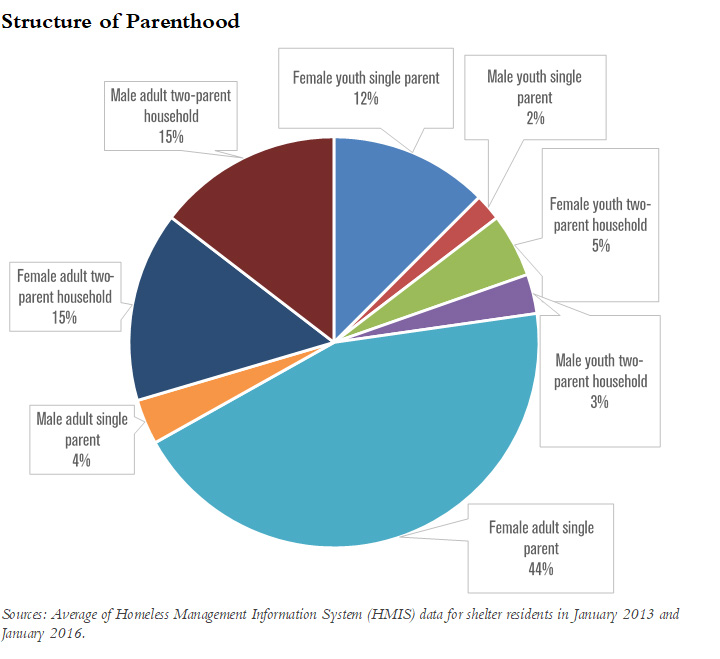 Youth-led households, that is, parents 18 to 24 years of age, make up a quarter of all homeless households with children. The share of young women in this age range who say they are pregnant is a third as large as those how have a child with them. These young parents still have the hope and energy of youth, yet are faltering in their transition to adulthood. They are an especially important group to support in obtaining jobs, subsidized childcare, and other needed assistance.
Youth-led households, that is, parents 18 to 24 years of age, make up a quarter of all homeless households with children. The share of young women in this age range who say they are pregnant is a third as large as those how have a child with them. These young parents still have the hope and energy of youth, yet are faltering in their transition to adulthood. They are an especially important group to support in obtaining jobs, subsidized childcare, and other needed assistance.
More homeless families are divided than remain intact. Given that many youth in institutional care are not successful in building a path to self-sufficient adulthood and are at risk of becoming second- or third-generation homeless, there is an important public interest in strengthening these families. This includes supporting parents in obtaining and keeping jobs, addressing behavioral health needs, and, when needed, developing successful parenting skills.
Work and Income
Efforts of homeless individuals to participate in the formal labor force are largely in the form of job seeking rather than job holding. The number of individuals looking for a job is four times greater than the number with a job.
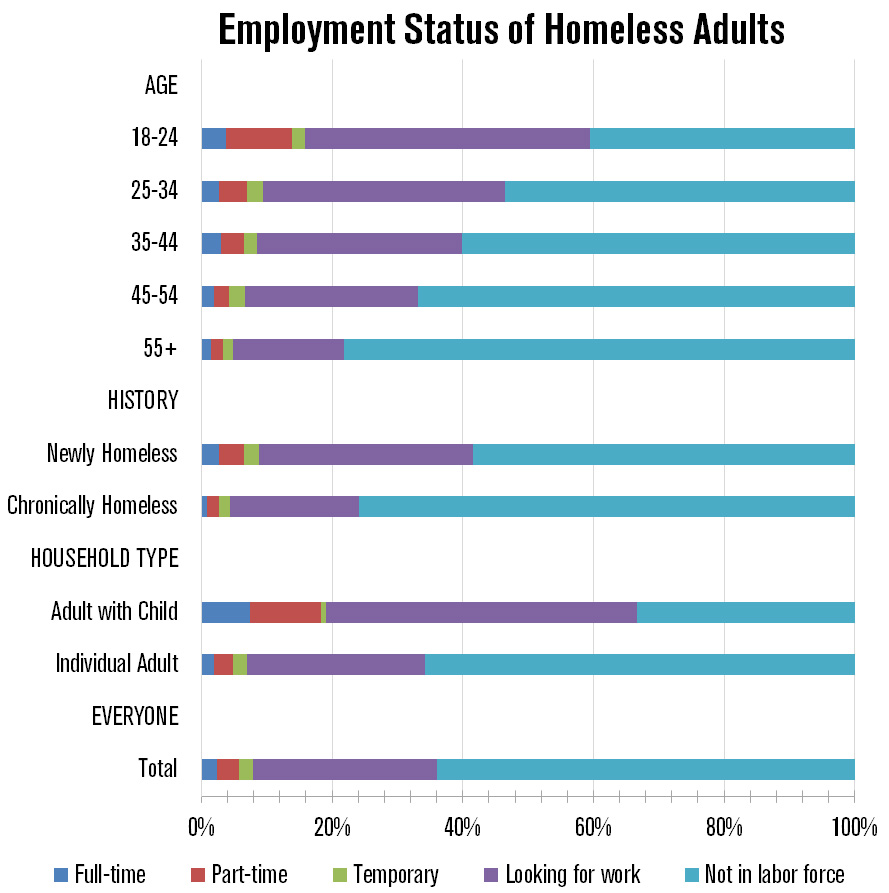 Two-thirds of homeless adults report making efforts to generate an income, but as individuals age and are homeless for longer intervals, this effort shifts from the formal labor market to informal, economically marginal activities.
Two-thirds of homeless adults report making efforts to generate an income, but as individuals age and are homeless for longer intervals, this effort shifts from the formal labor market to informal, economically marginal activities.
The major exceptions to this profile are young adults 18 to 24 years of age, parents with children, and individuals who have been homeless for three months or less. These three groups often overlap and are the low-hanging fruit for employment interventions.
Homeless workers rarely have full-time, year-round jobs, but if we annualize the monthly earnings of those who report having full-time work, their earnings are below the federal poverty threshold. Increasing the incomes of employable adults through jobs that pay at least the minimum wage is needed as a primary strategy for addressing homelessness.
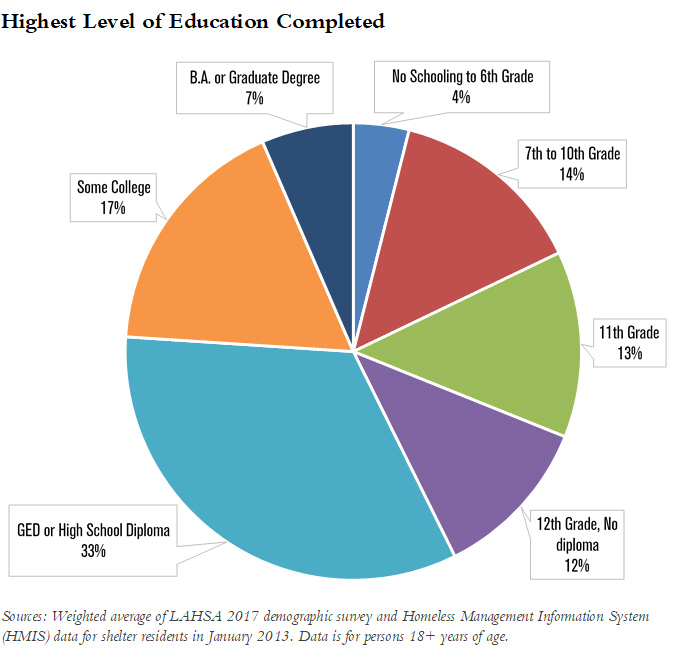 Almost three-quarters of homeless adults report having at least a high school degree and one-quarter report some level of college education. This level of educational attainment typically enables individuals to be part of the labor force and consistently earn an income.
Almost three-quarters of homeless adults report having at least a high school degree and one-quarter report some level of college education. This level of educational attainment typically enables individuals to be part of the labor force and consistently earn an income.
Given the massive ethnic disparities in homelessness, any employment-based intervention must address the discrimination and isolation that are barriers to sustaining employment for many African Americans, particularly men.
The entry of most homeless adults into sustaining jobs will need to be facilitated by strong financial incentives for employers to hire them and help them master their jobs. Other essential components of an integrated employment intervention include temporary housing, child care, transportation, clothing, behavioral health care, and interim income maintenance while waiting for a paycheck.
Considering that many of the people who are most interested in employment are parents, the multi-generational costs to society when those parents are marginalized and lack stability builds a strong case for the cost-effectiveness of targeted employment interventions. There are similarly strong cases for young adults and recently homeless individuals with employment histories.
Chronic Homelessness
The rate of chronic homelessness is roughly 30 percent for the total the point-in-time homeless population, but is progressively higher for older individuals.
Distinctive attributes of chronically homeless individuals include far fewer who are living with companions, accompanied by children, working, or looking for work. Every reported health condition is two to three times more prevalent among chronically homeless individuals than among first-time homeless.
Justice system histories are more prevalent among chronically homeless individuals. Two-thirds of chronically homeless men and half of chronically homeless women have been incarcerated.
Even though unequal social conditions create disproportionately large groups of homeless African-Americans and men, there are similar rates of chronic homelessness within each homeless ethnic and gender group. The risk of becoming chronically homeless is shared equally by all homeless individuals.
Recommendations
Develop and implement predictive analytic screening tools to prioritize and target interventions for new entrants into homelessness
1. Newly Homeless At Greatest Risk of Chronic Homelessness: Increase early and lasting exits from homelessness by using system-based screening tools to analyze linked administrative records from public and publicly-funded agencies for individuals who are newly homeless to identify those who are most likely to become chronically homeless and target them for immediate assistance.
2. Ongoing, Real-Time Linking of Client Records: Implement system-based screening programs using linked administrative records for healthcare, social services, homeless services, employment, and justice system involvement for individuals experiencing homelessness to identify newly homeless individuals who are at risk of chronic homelessness and prioritize them for targeted assistance. Use the Homeless Management Information System (HMIS) as a tool for informing service providers about individuals who have been prioritized for targeted interventions.
3. Prevent Homelessness: When a reliable predictive model has been developed, screen precariously housed clients who interface with County systems to identify those at greatest risk of entering homelessness.
4. Homeless Children: Investigate the long-term outcomes for children who experience homelessness and develop a reliable predictive model for identifying those at great risk of lasting harm.
Integrate mainstream human service delivery organizations in combating homelessness
5. System-Wide Engagement: Integrate all mainstream housing, social service, health care, and employment organizations into integrated, comprehensive efforts to help homeless residents achieve permanent exits from homelessness.
Provide targeted interventions
6. Vehicles as Dwelling Places: Help homeless individuals retain their vehicles by providing legal places to park together with hygiene facilities for occupants of the vehicles. In addition, provide cost-effective levels of financial assistance for paying vehicle registration and maintenance costs.
7. Family Support: Provide services for strengthening homeless families and equipping parents to care for and nurture their children, both those accompanying them and those in institutional care. This includes supporting parents in obtaining and keeping jobs, addressing behavioral health needs, and, where needed, developing successful parenting skills. Reducing risk for this group will provide multi-generational reductions in social service needs.
8. Shelter for Parents and Children: Provide immediate housing for homeless parents who are pregnant or accompanied by children and their families.
9. Justice System Diversion: Use arrests and incarceration as the last resort in responding to the life circumstances and actions of homeless individuals because arrest and incarceration increase the number of chronically homeless individuals. Expand already successful diversion programs into community based treatment and housing.
10. Transition Age Youth: Expand efforts to assist young adults 18 to 24 years of age experiencing homelessness, particularly those exiting foster care and juvenile detention. Needed services include skill development, employment, child care, behavioral health services, and integration into positive social networks.
11. Job Training: Improve access and suitability of education and job training opportunities for homeless individuals seeking employment who lack the skills needed to obtain a job.
12. Employment: Expand current efforts to place individuals experiencing homelessness in jobs. Attentions should be focused on new entrants into homelessness, young adults, and individuals who are parents. Services should include subsidized employment, temporary housing, child care, mobile phones, bus passes, clothes suitable for job interviews, and assistance in obtaining identity documents. Federal and state funded employment programs should assume a central role in providing intensive and comprehensive employment services for homeless residents.
Next Steps
This meta-analysis of information about homelessness experienced in Los Angeles County frames issues to be addressed through direct services as well as research. Chronic homelessness is a catastrophe and the result of multiple failures, both before and after the onset of homelessness.
The next stage of Economic Roundtable research is focused on developing predictive analytic screening tools.
Linked administrative records from client contacts with public social service and law enforcement agencies are being used to identify and stop this cascade of failures. These linked records reveal the course of individuals’ lives.
We are analyzing 15 years of linked records of individuals who experienced homelessness to identify factors associated with a high probability of becoming chronically homeless. These predictive factors can then be used to screen records of individuals who are newly homeless to identify those who are most likely to become chronically homeless and target them for immediate assistance.
The predictive screening tools will identify people for whom the escape route from homelessness costs less than the problem of remaining homeless.
These are homeless individuals likely to have high future costs for public services if there is not an intervention. They are also likely to have reductions in public costs after the intervention that offset the cost of the intervention. This type of predictive tool has already been developed to prioritize chronically homeless individuals for access to the scarce supply of permanent supportive housing. The new work will expand the array of evidence-driven interventions to include employment and services for foster youth.
PRESS COVERAGE AND ARTICLES
Without Rent Forgiveness, Experts Say Homelessness Will Just Get Worse
by Matt Tinoco, KCET, in collaboration with KPCC and LAist (April 7, 2020)
A Roof Is Only the Beginning
By Michelle Chen, The Nation (December 23, 2019)
Opinion: Fighting for survival: A veteran’s take on homelessness
By Lauren Romero, Seattle Times (December 13, 2019)
Los Angeles: Why tens of thousands of people sleep rough
By Daniel Flaming and Gary Blasi, BBC (September 19, 2019)
Jobs and work support could curtail L.A.’s stubborn homeless crisis, study says
By Gale Holland, Los Angeles Times (April 24, 2018)
Fighting for survival: A veteran’s take on homelessness
By Lauren Romero, The Seattle Times (December 13, 2019)
The $1.2 billion dollar challenge: Mitch O’Farrell
By Mitch O’Farrell, Los Angeles Daily News (July 8, 2019)
Weekly L.A. City Council Meeting Erupts After the Council Unanimously Approved an Ordinance that Criminalizes People Sleeping in their Car
By Lexis-Oliver Ray, L.A. Taco (July 31, 2019)
Homelessness Is Getting Worse In Southern California. Here’s Why
By Matt Tinoco, LAist News (May 10, 2019)
Housing, Homelessness and the California Dream
By Adriene Hill, The Mercury News (September 9, 2018)
How California’s Housing Crisis Turned Into A Homeless Crisis
By Adriene Hill, California Dream – Southern California Public Radio (August 27, 2018)
LA County’s homeless need more than housing to stay off the streets, report says
By Elizabeth Chou, Los Angeles Daily News (April 25, 2018 )
Report on L.A. County Homeless Highlights Need for Early Intervention Programs
My News LA (April 25, 2018)
Early Intervention and Jobs are Key to Stemming Chronic Homelessness in Los Angeles
By Denise Luu, City Watch (April 26, 2018)
Intervening early is the best way to reduce chronic homelessness
By Kevin Ebi, American City & County (April 30, 2018)
Report: Early Intervention and Jobs are Key to Stemming Chronic Homelessness in Los Angeles
Santa Monica Mirror (April 29, 2018)
LA County Homeless Report Highlights Need for Early Intervention Programs
Long Beach Post (April 26, 2018)
Report on L.A. County Homeless Highlights Need for Early Intervention Programs
West LA News (April 25, 2018)
New Study: Early Exit from Short-term Homelessness Prevents Worse Scenarios
Capital & Main (April 25, 2018)
Broadcast Coverage of Escape Routes
KPCC-FM (Radio) – Los Angeles, CA
April 25, 2018, 4:30 PM; April 26, 2018, 7:30 AM
KCRW-FM (Radio) – Los Angeles, CA
April 25, 2018, 9:00 AM, 3:00 PM; April 26, 2018, 12:30 PM, 8:00 AM, 6:30 AM
KNX-AM (Radio) – Los Angeles, CA
April 25, 2018, 7:30 AM
KFI AM – Los Angeles, CA
April 25, 2018, 7:30 AM, 11:00 AM, 1:30 PM, 3:00 PM; April 26, 2018, 9:00 AM, 7:00 AM, 5:00 AM, 2:00 AM


